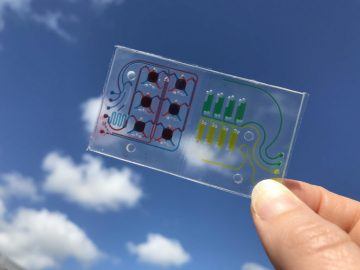Shraddah Chakradhar in Stat:
 An unusual bit of cargo was aboard the latest Space X mission to restock the International Space Station with essential supplies in the early hours of Saturday morning. Usually, these SpaceX launches carry clothes or equipment that astronauts aboard the ISS may need to fix minor issues. But this latest launch also included tiny structures — about as big as a USB drive — containing human cells and known colloquially known as “organs on chips” were launched into space as part of a new experimental program from the National Institutes of Health’s National Center for Advancing Translational Sciences. These tissue chips are designed, with the help of pumps and other fluidics, to mimic the function of an organ. They’re used to study a wide range of diseases as well as test potential treatments. Most of the experiments with tissue chips have been confined to Earth. But in December, the first of five teams funded by the NCATS program launched an organ chip containing immune cells into space. The chips from the four other teams — roughly 50 chips in total — were packed into shoebox-sized boxes, along with all the material to help keep them going and sent along on a space capsule called Dragon. And if all goes to plan, the ISS will capture the capsule this morning. Over the next few weeks, the teams behind these tissue chips are hoping to learn all about what space — specifically, microgravity in space — does to human cells. I chatted with Lucie Low, the program manager of Tissue Chips in Space, to learn more about the mission. This interview has been condensed and lightly edited.
An unusual bit of cargo was aboard the latest Space X mission to restock the International Space Station with essential supplies in the early hours of Saturday morning. Usually, these SpaceX launches carry clothes or equipment that astronauts aboard the ISS may need to fix minor issues. But this latest launch also included tiny structures — about as big as a USB drive — containing human cells and known colloquially known as “organs on chips” were launched into space as part of a new experimental program from the National Institutes of Health’s National Center for Advancing Translational Sciences. These tissue chips are designed, with the help of pumps and other fluidics, to mimic the function of an organ. They’re used to study a wide range of diseases as well as test potential treatments. Most of the experiments with tissue chips have been confined to Earth. But in December, the first of five teams funded by the NCATS program launched an organ chip containing immune cells into space. The chips from the four other teams — roughly 50 chips in total — were packed into shoebox-sized boxes, along with all the material to help keep them going and sent along on a space capsule called Dragon. And if all goes to plan, the ISS will capture the capsule this morning. Over the next few weeks, the teams behind these tissue chips are hoping to learn all about what space — specifically, microgravity in space — does to human cells. I chatted with Lucie Low, the program manager of Tissue Chips in Space, to learn more about the mission. This interview has been condensed and lightly edited.
What types of chips are going into space? And what conditions are they hoping to provide information about?
There’s a kidney kit that’s looking at osteoporosis and the formation of kidney stones. We also have a knee joint kit that will look at osteoarthritis. Then there’s a blood-brain barrier kit to look at neurodegenerative disease. And finally, a lung kit to look at the impact of pathogens on lungs.
More here.
